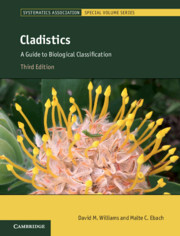Book contents
- Cladistics
- The Systematics Association Special Volume Series
- Cladistics
- Copyright page
- Dedication
- Contents
- Preface
- Acknowledgements
- Introduction: Carving Nature at Its Joints, or Why Birds Are Not Dinosaurs and Men Are Not Apes
- Part I The Interrelationships of Organisms
- Part II Systematics: Exposing Myths
- Part III The Cladistic Programme
- Part IV How to Study Classification
- 8 Modern Artificial Methods and Raw Data
- 9 How to Study Classification: Consensus Techniques and General Classifications
- 10 How to Study Classification: ‘Total Evidence’ vs. ‘Consensus’, Character Congruence vs. Taxonomic Congruence, Simultaneous Analysis vs. Partitioned Data
- 11 How to Study Classification
- 12 How to Study Classification
- Part V Beyond Classification
- Afterword
- Index
- Systematics Association Special Volumes
- References
9 - How to Study Classification: Consensus Techniques and General Classifications
from Part IV - How to Study Classification
Published online by Cambridge University Press: 20 July 2020
- Cladistics
- The Systematics Association Special Volume Series
- Cladistics
- Copyright page
- Dedication
- Contents
- Preface
- Acknowledgements
- Introduction: Carving Nature at Its Joints, or Why Birds Are Not Dinosaurs and Men Are Not Apes
- Part I The Interrelationships of Organisms
- Part II Systematics: Exposing Myths
- Part III The Cladistic Programme
- Part IV How to Study Classification
- 8 Modern Artificial Methods and Raw Data
- 9 How to Study Classification: Consensus Techniques and General Classifications
- 10 How to Study Classification: ‘Total Evidence’ vs. ‘Consensus’, Character Congruence vs. Taxonomic Congruence, Simultaneous Analysis vs. Partitioned Data
- 11 How to Study Classification
- 12 How to Study Classification
- Part V Beyond Classification
- Afterword
- Index
- Systematics Association Special Volumes
- References
Summary
In 1972, Edward N. Adams III published what might be the first paper on consensus techniques for use in biological classification. He addressed the following question: ‘… can we combine the information from rival classifications into a new, hopefully more accurate classification? Such a consensus of the rivals is useful both in tree comparison and tree discovery’ (Adams 1972, p. 390). Since Adams’ paper, nearly half a century ago, numerous consensus tree techniques have been proposed, numerous critiques of each have been published and an almost infinite number of suggestions have been made as to how to use one of them, some of them, any of them, all of them, or none of them (Bininda-Emonds 2004a, 2004b). Alongside this avalanche of technical detail are discussions concerning supertrees (which are a form of consensus analysis) and supermatrices, the latter being an extension of the ‘combining data’ debate (Sanderson et al. 1998, see the following Chapter 10). Again, as with the methods of data analysis described in Chapter 8, we do not intend to discuss each and every consensus technique in detail but deal with what we understand to be the basic issues (on the details of consensus methods, we make some suggestions in the Further Reading section below).
- Type
- Chapter
- Information
- CladisticsA Guide to Biological Classification, pp. 237 - 252Publisher: Cambridge University PressPrint publication year: 2020
References
References
Further Reading
These are two useful summaries of the methods available at that time. Bear in mind that most contributions to Bininda-Emonds (2004) are still immersed in finding better methods rather than exploring the actual data.

